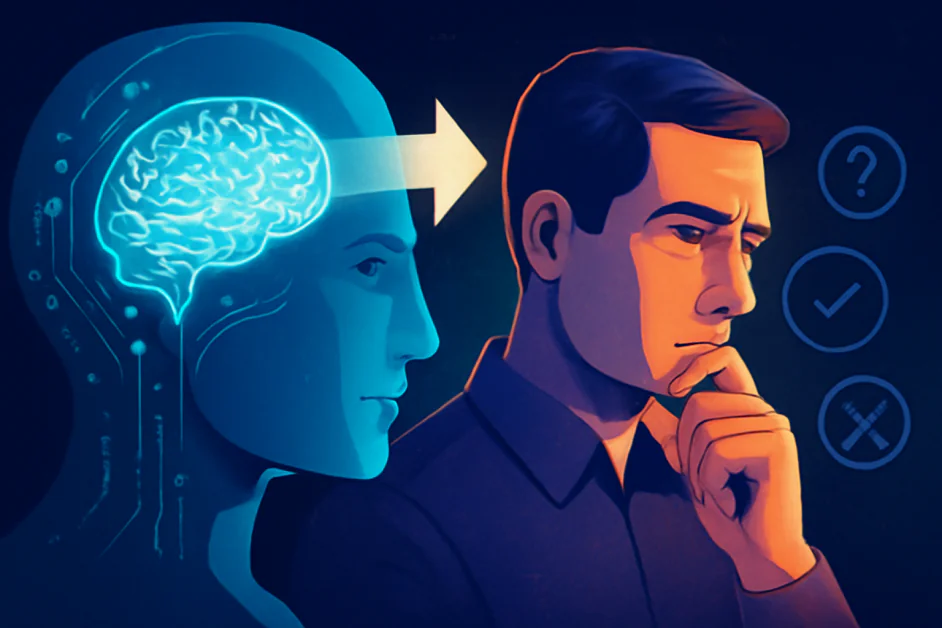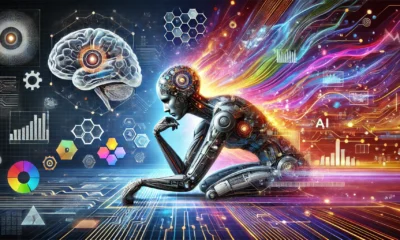ဉာဏ်ရည်တု
How AI is Changing Our Understanding of Human Decision-Making

Understanding human decision-making has been a central goal in psychology for decades. Researchers have long sought to design cognitive models that explain how people think and predict their behavior. Now, the rise of artificial intelligence (AI) is fundamentally transforming this field. Recent breakthroughs in AI are revealing new insights into the mental processes that underlie our choices. At the center of this transformation is an innovative approach called “Centaur Mode,” where AI and human intelligence work together in ways that highlight the nature of human cognition.
The Dawn of a New Era in Cognitive Science
Centaur is a foundation AI model of human cognition that can predict and simulate human behavior with striking accuracy. The model is trained on more than ten million individual decisions made by over 60,000 participants across 160 psychological experiments. Created by researchers at Helmholtz Munich, the model is designed to bridge the gap between traditional cognitive theories and modern AI capabilities. The name “Centaur” originates from the mythological creature with a human upper body and horse-like legs. This naming reflects the model's unique ability to combine human-like decision making with the predictive power of artificial intelligence. The model can simulate human behavior in situations it has never encountered before. When researchers test it on new psychological experiments, Centaur responds in ways that mirror real human choices. This capability suggests that AI can now capture fundamental patterns in how humans make decisions across different contexts.
The Foundation: Psych-101 Dataset
The secret behind Centaur's success lies in its training data. The researchers created Psych-101, a dataset containing over 10 million individual decisions from more than 60,000 participants across 160 psychological experiments. This comprehensive collection encompasses trial-by-trial data from psychological studies, encompassing memory games, gambling tasks, and problem-solving scenarios. Each experiment was carefully transcribed into text to prepare the data. This natural language data allows researchers to process human behavioral data using large language models in a way that preserves the rich context of experimental settings. This approach enables the model to understand not only how people decide, but also the circumstances under which they make those decisions.
How Centaur Works
Centaur is built on Meta's Llama 3.1 70B language model and fine-tuned using a technique called quantized low-rank adaptation (QLoRA). This method modified only 0.15% of the base model's parameters while achieving remarkable improvements in predicting human behavior.
The training process involved showing the model complete transcripts of psychological experiments, including everything participants were told, what they saw, and what they did. The model learned to predict human choices by analyzing patterns across millions of decisions, gradually developing an understanding of human cognitive processes.
စွမ်းဆောင်ရည် အတားအဆီးများကို ချိုးဖောက်ခြင်း။
Centaur has shown an impressive performance across multiple metrics. It achieved 64% accuracy in predicting human behavior, significantly outperforming previous models that could only predict certain aspects of human behavior with much lower accuracy. In rigorous testing across 160 experiments, Centaur consistently outperformed traditional cognitive models, including established theories like အလားအလာ သီအိုရီ and reinforcement learning frameworks.
Perhaps most remarkably, Centaur demonstrated its ability to generalize beyond its training data. The model successfully predicted human behavior in experiments with modified cover stories, structural changes, and entirely new domains it had never encountered before. This generalization ability suggests that Centaur has learned fundamental principles of human cognition rather than merely memorizing specific patterns.
အဓိကတွေ့ရှိချက်များ
One of the most striking discoveries from Centaur research is the alignment of the model's internal representations with human neural activity. This discovery suggests that when AI learns to predict human behavior, it develops internal processes that mirror aspects of human cognition. Despite being trained only on behavioral data, Centaur showed improved ability to predict human brain activity measured through fMRI scans.
This unexpected neural alignment suggests that the model may have uncovered genuine insights into how the human brain processes information. The fact that a model trained purely on behavioral choices can predict neural responses indicates that behavior and brain activity share underlying computational principles.
This discovery suggests that human decision-making may be more predictable than previously thought. The patterns that Centaur learns from human choices reveal underlying structures in how we process information and make decisions. These patterns are observed across various types of decisions, ranging from simple memory tasks to complex problem-solving scenarios.
The research also shows that AI can capture human cognitive biases. When Centaur makes predictions, it exhibits the same systematic errors and shortcuts that humans use in decision-making. This finding suggests that these biases are not flaws in human thinking but rather integral parts of how our cognitive systems work. They represent efficient strategies that our brains use to navigate complex environments with limited resources.
The Centaur reveals that our choices are not random or purely logical. They follow patterns that can be learned and predicted, but these patterns are complex and context-dependent. Centaur demonstrates that human decision-making involves a complex interplay of cognitive processes that interact in sophisticated ways.
A New Window into Human Thinking
Traditional psychology has long sought to understand human decision-making through isolated studies and theoretical models. The Centaur approach represents a different path. By training AI on massive amounts of human behavioral data, researchers can now test theories about decision-making at unprecedented scales. When AI makes predictions about human behavior, researchers can compare these predictions with actual human choices to identify gaps in current psychological theories. This process creates a feedback loop where AI helps us understand ourselves better.
Beyond feedback, Centaur can be used for scientific discovery. The researchers demonstrated this by using the model in conjunction with language models, such as DeepSeek-R1, we can generate new hypotheses about human decision-making strategies. This approach, known as scientific regret minimization, enables researchers to identify patterns in human behavior that existing theories cannot explain.
Centaur represents a new paradigm in cognitive science, where AI models serve as both subjects of study and tools for generating new theoretical insights. The combination of large-scale behavioral data and AI's capabilities opens possibilities for discoveries that would be impossible through traditional experimental approaches alone.
စိန်ခေါ်မှုများနှင့် အနာဂတ်လမ်းကြောင်းများ
While the development of Centaur is a significant advancement in cognitive science, critical challenges remain. The model's predictions are based on patterns from psychological experiments, which may not fully capture the complexity of real-world decision-making. Human choices in laboratory settings may differ from those in natural environments, where the stakes are higher and contexts are more complex.
There are also questions about the generalizability of these findings across different populations and cultures. The psychological studies used to train Centaur primarily involved participants from specific demographic groups. Understanding how decision-making patterns vary across different cultures and contexts remains an active area of research.
The ethical implications of AI systems that can predict human behavior also require careful consideration. While these tools can provide valuable insights, they also raise questions about privacy and the potential for manipulation. As AI becomes better at understanding human decision-making, we need frameworks to ensure these capabilities are used responsibly.
The development of Centaur represents just the beginning of a new era in cognitive science. The researchers plan to expand the dataset to include more diverse populations, demographic information, and psychological characteristics. Future versions may incorporate multimodal data, including visual and auditory information, to capture a more complete picture of human cognition.
The success of Centaur also points toward the development of more sophisticated cognitive architectures that combine domain-specific and domain-general modules. This could lead to AI systems that not only predict human behavior but also exhibit more human-like reasoning capabilities.
The Bottom Line
Centaur represents a shift in how we the study human cognition. By combining the scale and power of modern AI with the rich tradition of psychological research, it offers new insights into human decision-making. While challenges remain, the model's success in predicting behavior across diverse domains suggests that we are entering a new era where AI and cognitive science can work together to unlock the mysteries of the human mind.












